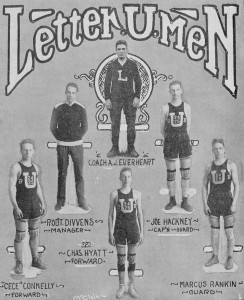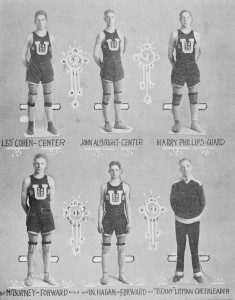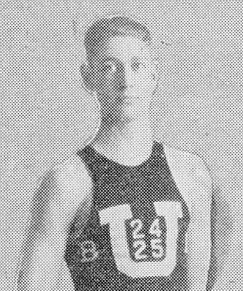This article was researched and written by PA Room volunteer Paul Davis. Thanks to Paul for contributing!
Fayette County has always had a rich sports history. If one were to visit the Fayette County Sports Hall of Fame located here in the Uniontown Library they would learn about the varied accomplishments by many talented men and women. Basketball, in particular, has been a powerhouse sport in the area.
Being alumni of Uniontown High School, my first thoughts are to the glory years of UHS basketball, teams like the 1962, 1964,and 1981 Uniontown men’s teams. The alumni of Laurel Highlands probably remember the 1968 men’s team, while those from Geibel reminisce about the 1978 men’s team or the 1993-1996 women’s dynasty teams. However, long before all of these great teams there was the one that started it all. The 1925 Uniontown men’s basketball team was the first to inspire and unite the area with its dominance on the court.
The 1925 team played in a very different era for the sport of basketball that we are familiar with today, so any delusions of turning this into a “which team is better” post is not possible. The game was more defensive and more possession-based that today’s game. There was no shot clock as it was not invented until 1954 so stalling was a viable tactic. This caused much lower scores than in the modern era. Fouling was really one of the only ways to force a change in possession. In addition, balls were not as well made. They tended to be flatter and there were laces on the outside. These factors made it more difficult to play the game smoothly and taking advantage of mistakes was a large part of the game.
The 1925 Uniontown men’s basketball team was a force to be reckoned with. They dominated their regular season, won the W.P.I.A.L. championship and the State Championship, and then went on to compete at the national tournament in Chicago. The team was made up of a famous group known as the “Five Horseman.” Recently this photograph of the “Five Horseman” was donated to the Pennsylvania Room and it sparked my curiosity to dive into this subject.
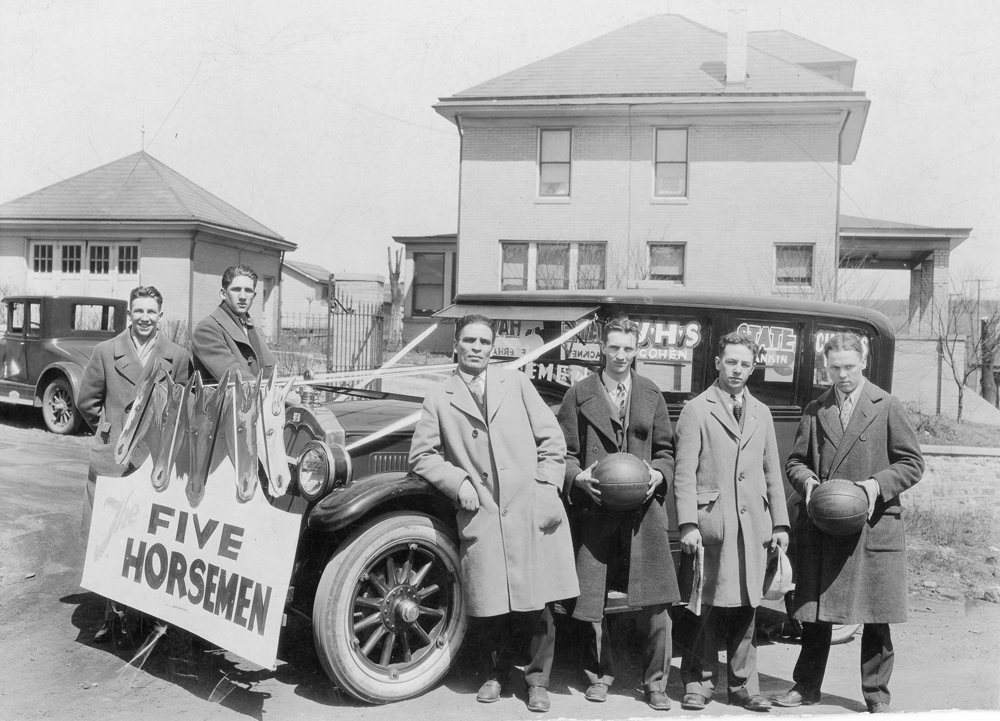
Uniontown Basketball Starting Five and Coach Everhart
These five players were primarily the starters, although that was occasionally changed depending on the matchup. The team was coached by A.J. Everhart Sr. (the older gentleman in the middle of the photograph), father of Abe Everhart who famously coached the 1962 and 1964 Uniontown basketball teams. In the photograph the “Five Horsemen” comprised, from left to right, of Charles Hyatt, Lester Cohen, Joseph Hackney (the captain), Cecil Connelly, and Marcus Rankin. The rest of the team comprised of George Adams, I.N. Hagan (an influential figure in Fayette County—but more on that later), John S. (Bus) Albright (the sixth man), Robert McBurney, Charles Miller, and Harry Philips.
The team played their games at what was known as the Gallatin Gardens. It was located where the remnants of the Laurel Lanes bowling alley are on Gallatin Avenue. Currently that section of the building is vacant. The team only lost two games all season and had 30 wins over the course of the year. They were able to put up some very impressive numbers during that stretch as they were able to score 1417 points and hold their opponents to only 615. They played three teams from colleges or normal schools and defeated two of them. The only regular season loss was to the University of Pittsburgh freshman team and many considered that to be an off night.
Some of the more impressive victories from the regular season included defeating Indiana 42-1 and defeating the California Normal School 52-28. The game against California really impressed a lot of people, as the 1925 Uniontown Yearbook states, “As a whole, the game was one of the best ever played at the Gardens. Uniontown worked more or less as one man and showed what they could really do when they had to.”
The team was dominant in the tournaments as well. They played their closest game all year in the second round of the W.P.I.A.L tournament against Homestead. They took a 24-13 lead early in the game and were able to hold on for dear life and defeat Homestead 24-22. They cruised through the rest of the tournament, and then they marched through the State tournament to qualify for a chance to win the national title in Chicago.
In the national tournament, the “Maroon Tornado” shocked the basketball world in their first win over the Greeley teacher’s college (now known as the University of Northern Colorado). Greeley was one of the favorites to win the tournament and had defeated the 1924 National Champions twice that year. They never truly threatened in the game, however, and Uniontown cruised to a 26-11 victory.
The next team to be swept up by the “Tornado” was Lakeview, which happened to be from Chicago. This caused Uniontown to virtually be the visiting team but according to Joe Hackney, “By the time the game was nearing its end the crowd was rooting for us.” Behind this new enthusiasm they surged to a 29-11 victory and in the process made history. No Pennsylvania team had gone this far in the national tournament until that point.
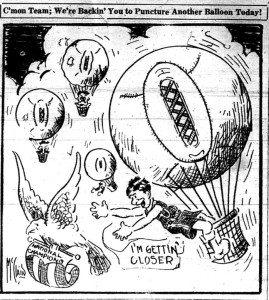
This cartoon appeared in the Morning Herald on Friday April 3, 1925 after the teams win over Lakeview.
The support for the team was through the roof from the fans back in Pennsylvania during the whole season, but it reached a fever pitch while the team was in the National Tournament. Fans gathered in the Gallatin Gardens during the games in Chicago and play-by-play updates were announced whenever they were available via either telegraph or telephone. There were dedicated cheering sections and even half-time entertainment. Dave Harmen, an entertainer who was booked at the State Theater for the week, came by and put on part of his act during half-time. The support did not come from just Uniontown or even just Fayette County, though. The Morning Herald’s phone lines were constantly tied up during the games from people calling in to request the score. They noted that they even received calls from all of Western Pennsylvania. They mention one man from Monessen called claiming that his place of business was being besieged by local calls wishing for game updates.
Local fans wished to help the team any way they could and as a result fundraisers were established. One notable group was called the One Thousand Dollar club. They were established to buy the team gifts upon their return from Chicago as a sign of gratitude from the residents of the city for bringing so much joy to the area. As the name suggests they set out to obtain at least $1,000 through tagging and donations. Most of the work was done by the girls from Uniontown High School and they were able to raise $1,200 overall. They put it to good use and bought the boys sweaters, watches, and rings among other items.
As dominant as Uniontown was in their lead up to the third game of the tournament, the numerous amount of games they had played was beginning to take its toll. They had played 31 games to Wichita’s 20 and came into the game running on fumes. It did not help matters that Wichita was one of the tallest and strongest teams they had faced all season. The game was tied going into halftime with a score of 17-17 but then fatigue set in and Wichita dominated. The end result was a Wichita victory by the score 42-21. Wichita went on to win the national title and in an special article written in the Chicago Tribune, but featured in the Morning Herald, those who knew the sport best accurately predicted that the winner of the Uniontown vs. Wichita game was going to win the National Championship. Unfortunately for the hometown boys they were on the wrong side of the outcome. The team manager Robert Divvens, summed it up accurately in an editorial piece in the 1925 Uniontown Yearbook, “Napoleon met his Waterloo, so did we!!”
Despite the defeat the team held their heads high as they traveled back to Uniontown. The fans were also eager to see their team return home and they gave them a hero’s welcome. The team’s train was to arrive in Connellsville and the team would return to Uniontown via car. The city of Connellsville had commissioned the Connellsville military band to welcome the team and encouraged the city to come out, as well. A large contingency of Uniontown fans came to greet the team with a band of their own. It was estimated that over 3,000 fans gathered at the train station.
From there the team joined a procession on the trip from Connellsville back to Uniontown, where as many as 30,000 people came out to greet the team. Once the cars reached the intersection of Gallatin Ave. and Main St. the crowd was so large the cars could not continue. Schools were closed and the mayor personally encouraged fans to celebrate downtown for the rest of the day.
Later in the evening the team held a meet and greet in the Ella Peach building (now Central School). They were met by an estimated 2,500 fans. The High School orchestra played as fans piled into the school and after they were finished the team was led down the street to the Gallatin Gardens where a dance was held in their honor. Fans that could not enter the dance were encouraged to continue celebrating in the streets. It was an all-day party for the city and it showed just how proud the area was of this team.
After that glorious year the city and the team moved on. They still had some amazing teams in the next few years but none matched the sheer dominance of the 1925 “Five Horseman” team. The players grew up and had lives of their own. John Albright, the team’s sixth man, made an impact in Fayette County sports even more down the road but not due to his athletic ability. After high school, he played basketball for The University of Pittsburgh but was forced to give it up due to ill health. Afterwards he decided to focus teaching athletics to children. He became a Physical Education teacher at Lafayette for some time and was the coach of the Uniontown Men’s Basketball team throughout the mid-1940s.
However, Albright’s most prominent role came when he founded the Uniontown Recreation Department in 1945. Their goal was to establish places for children to be active and play outside. The Department created numerous playgrounds around the city including Bailey Park and the playgrounds at Lafayette and Benjamin Franklin schools. His contributions to the area went well beyond his high school days and he was awarded for his work as an advocate for an active lifestyle with Special Recognition status in the Fayette County Sports Hall of Fame.
Another member who made a name for himself was I.N. Hagan. Hagan did not see a lot of playing time during the 1925 season but he became an important figure in the Uniontown business world. He became the third generation president of the Hagan Ice Cream Co. which was founded by his grandfather in 1878. He took great steps in expanding the company and during his reign the company began to not only manufacture ice cream, but sell it. He opened numerous Hagan Ice Cream shops around the area to further the brand. After selling the company in 1975, Hagan continued to be involved in numerous local endeavors such as Gallatin Bank and the Fayette County Chamber of Commerce. He is also notable for owning and living in the Frank Lloyd Wright house, Kentuck Knob, with his wife for 30 years. Hagan’s contributions left a lasting mark on the landscape of the Fayette County business scene.
Perhaps the most famous alumni of the 1925 basketball team made a lasting name for himself in the sport. Charles Hyatt graduated from Uniontown and played his college basketball at the University of Pittsburgh, winning two National Championships in the 1927-28 season and the 1929-30 season. While he was on the Pitt team he was the nation’s leading scorer twice, scoring 880 points during his career. After college, he decided not to play professional basketball and moved to California and played amateur basketball in the Amateur Athletic Union (AAU).He won numerous AAU national titles and accolades as a player-coach over his roughly fifteen-year career. Hyatt was inducted in the Naismith Memorial Basketball Hall of Fame in 1959.
The 1925 Uniontown men’s basketball team made a lasting impression on many on the community both on and off the court. They brought the area together and made us proud of our homegrown talent. For me, learning about them has been a fascinating endeavor. I barely knew the team existed before this write-up but now, I’m enthralled with them. There is more information to be found on this special group in the Yearbooks and newspaper articles tucked away in the Pennsylvania Room. If interested come on down and do some digging of your own. You won’t regret what you find.


